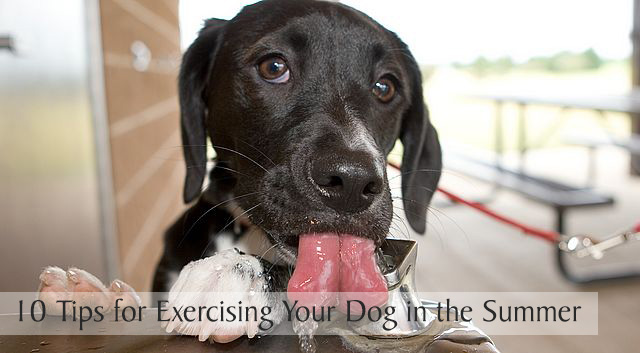 Exercising your dog is important all year long. Last fall I wrote 12 Easy Ways to Exercise Your Dog in the Winter, so with the temperatures starting to warm up and summer being right around the corner, I wanted to share some safety tips for exercising your dog in the summer. High heat and humidity levels can pose a risk to your dog’s health, so whether you’re hanging out around the house this summer or preparing for a vacation at the beach, keep these tips in mind to keep your dog cool and comfortable.
Exercising your dog is important all year long. Last fall I wrote 12 Easy Ways to Exercise Your Dog in the Winter, so with the temperatures starting to warm up and summer being right around the corner, I wanted to share some safety tips for exercising your dog in the summer. High heat and humidity levels can pose a risk to your dog’s health, so whether you’re hanging out around the house this summer or preparing for a vacation at the beach, keep these tips in mind to keep your dog cool and comfortable.
10 Tips for Exercising Your Dog in the Summer
1. Don’t leave your dog in a parked car.
If you drive somewhere to exercise your dog, please don’t risk your dog’s life by leaving her in a parked car when it’s warm outside. Every summer we read heartbreaking stories about dogs that die from heatstroke because they were left alone inside of vehicles. I can’t imagine there are still people out there that haven’t heard about the risk of doing this or maybe they ignore the warnings thinking that they’ll only be gone for a few minutes and their windows are cracked open. On a warm day, it only takes a few minutes for the temperature inside a closed vehicle to reach a dangerous level for a pet and it’s worth noting that it’s illegal to do this in many states.
2. Keep a close eye on your dog.
The best way to protect your dog when the weather gets hot is to be observant of her behavior. If you notice signs like excessive panting or your dog seems hot, tired or draggy, she may be starting to get uncomfortable from the heat. By watching her behavior carefully, you can prevent dehydration or heatstroke before it happens. Energetic, fun-loving dogs can become overheated and dehydrated while playing, so give them frequent breaks from the action and lots of water to drink.
3. Keep high-risk dogs indoors.
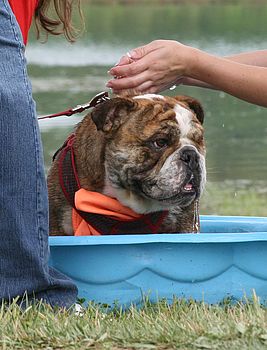
Certain dogs are at increased risk for heat related illnesses and should mostly be kept indoors when it’s hot and humid. High temperatures can be extremely hard on older dogs, very young dogs, overweight dogs and dogs with short muzzles (bulldogs, pugs, Boston terriers, etc.) Dogs with heart or respiratory diseases should also be kept inside where it’s cooler. Most dogs appreciate being indoors if the weather is extremely hot, especially dogs with thick double coats.
4. Know the symptoms of dehydration and heatstroke.
In hot weather, dogs can easily become dehydrated if they don’t drink plenty of cool, fresh water. Signs of dehydration include lack of skin elasticity, sunken eyes, dry or sticky gums, lethargy, changes in urination and slow capillary refill time after pressing on their gums. One way to check for dehydration is to pull up your dog’s skin on the scruff of their neck and watch how quickly the skin returns to its normal position when you let go. If the skin doesn’t return to its normal position almost immediately or after just a second or two, your dog could be dehydrated. Prevent dehydration by making sure your dog always has plenty of fresh water available to drink. Heatstroke occurs when a dog’s temperature rises to a level where they can no longer cool themselves normally. Symptoms include heavy panting, drooling (early on), an anxious expression, staring or glazed eyes, failure to respond to commands, fever, rapid heartbeat, lethargy, bloodshot eyes, excessive thirst, difficulty breathing, lack of coordination, vomiting, deep red or purple tongue or gums, seizures and unconsciousness. Dehydration and heatstroke are serious medical conditions that need immediate attention and treatment. See the section below to learn what you should do if you think your dog may have heatstroke.
5. Limit exercise duration and intensity.

As temperatures and humidity levels climb, plan to adjust your dog’s exercise routine accordingly. Overweight dogs and dogs with darker colored coats tend to get overheated quicker when exercising in the sun and heat, so walk or exercise in the early morning or late evening when it’s cooler or take shorter walks in areas that are heavily shaded. Although I’ve never tried one on Haley, some dogs may enjoy wearing a cooling vest while exercising. If you’re visiting an area that’s much warmer than what your dog is accustomed to, allow her to adjust gradually to the warmer climate. Water-related activities are perfect for keeping dogs cool on sweltering summer days.
Head for the swimming pool or lake, fill a kiddie pool with water in the backyard or turn on a sprinkler for your dog to run through. If you discover your dog digging in the yard and resting on exposed dirt, consider building a digging station or buy a cooling pad for her to relax on.
6. Always provide cool, fresh water.
Your dog should always have access to water. Don’t just check to make sure her bowl is filled, but change the water often to ensure it’s fresh and cool. If you’re hiking or exercising your dog away from home, carry a water bottle with you and stop often to allow her to drink. If your dog doesn’t like drinking directly from the bottle, take along a small collapsible bowl or a hinged bowl that’s made to screw on to the end of a water bottle. In a pinch, you can even cup your hand under the water bottle to form a bowl that your dog can drink from.
7. Maintain a cool environment for your dog.
While in the yard, make sure your dog has a well-ventilated shady area to rest and cool off and keep the temperature comfortable for your dog inside the house when you’re away from home. Fans come in handy when a little extra air circulation is needed. Never keep a dog outside when it’s extremely hot and humid. If the conditions are unbearable for you to sit outside, it’s probably not safe or pleasant for your dog either.
8. Protect those paw pads.
Hot pavement or beach sand can cause severe burns to a dog’s paw pads. Sometimes us shoe-wearing humans forget just how hot some walking surfaces get in the summertime. To keep those paw pads healthy, walk your dog in grassy areas, have her wear summer booties or apply a protective wax like
Musher’s Secret to her paw pads before heading out for your walk.
9. Protect your dog’s skin.
Short-coated and white colored dogs have less protection from the sun’s harmful rays. Protect your dog from skin cancer by using a pet safe sunscreen, particularly on their nose, ears and any areas of pink skin. The ongoing debate about shaving dogs with long hair or heavy coats continues, but most people agree, it’s much safer to do daily grooming and a light trimming of the coat rather than shaving a dog which can leave their skin unprotected from the sun.
10. Avoid using a muzzle.
Dogs have very few sweat glands, most of which are found on their paw pads. Their primary method of cooling off is through panting. Any restrictive muzzle or head gear that prevents a dog from panting normally in order to cool down can be dangerous to use in hot weather. A good alternative would be a greyhound-type muzzle if it’s appropriate for your dog.
I hope you never have to treat a dog for heatstroke, but it’s good to know what to do in case you’re ever facing this emergency.
Treating Heatstroke in Dogs
Heatstroke (hyperthermia) is a serious condition that requires immediate treatment. If a dog is suffering from heatstroke, you must work quickly to lower the body temperature of the dog and transport it to a veterinary clinic as soon as possible.
Move the dog to a shady or cooler location if possible and apply cool water to the dog’s body by using a hose or a towel soaked in cool water. Focus first on the neck, belly, head and paw pads and refresh the towel with the cool water every few minutes. Offer some cool water to drink and take the dog’s temperature, if possible.
A dog’s normal body temperature can be between 100.5 to 102.5 degrees (Fahrenheit). 103 degrees and above is considered a fever with possible permanent tissue and organ damage occurring around 106 degrees.
The goal for treating a dog with heatstroke is to reduce the dog’s temperature to 103 degrees in the first 10-15 minutes, then stop the cooling process to allow the dog’s temperature to regulate back to a normal level which will prevent over cooling and having the temperature dip too low. Even if your dog seems to have recovered from an episode of heatstroke, it’s still important to have her evaluated by a vet to make sure there are no complications from the event.

Let’s keep our pups safe this summer and if you’re planning a beach vacation, check out 15 Tips for Taking Your Dog to the Beach!
Share your ideas, favorite products or tips on exercising your dog in the summer.
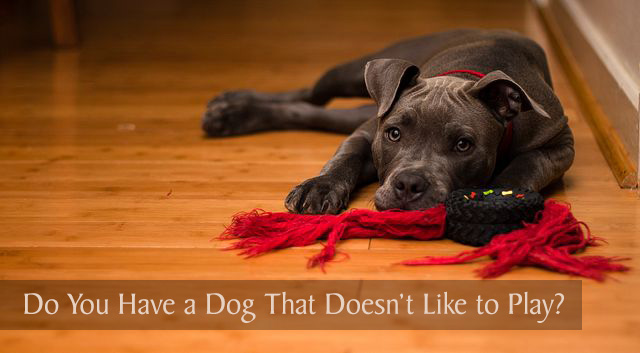
 Puppies are born to eat, drink, sleep, poop and play! Play is an important part of their young lives and it’s through play that they learn manners and how to get along with one another. So we know at least during this phase of a dog’s life that they like to play. When someone tells me their adult dog doesn’t like to play, I often wonder about the old nurture vs. nature debate. Is it in their dog’s nature to not enjoy playing or did the dog owner not play very much (or at all) with their dog? I know it’s somewhat common for rescue dogs to not know how to play which makes me think it’s more about nurture than nature.
Puppies are born to eat, drink, sleep, poop and play! Play is an important part of their young lives and it’s through play that they learn manners and how to get along with one another. So we know at least during this phase of a dog’s life that they like to play. When someone tells me their adult dog doesn’t like to play, I often wonder about the old nurture vs. nature debate. Is it in their dog’s nature to not enjoy playing or did the dog owner not play very much (or at all) with their dog? I know it’s somewhat common for rescue dogs to not know how to play which makes me think it’s more about nurture than nature.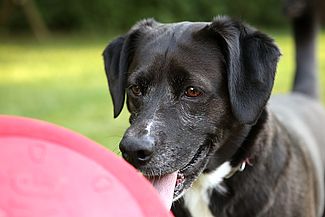 There are various ways to play with a dog and certainly different dog breeds prefer different play styles. Retrievers typically like to fetch, scent hounds love playing Find It or Hide and Seek games using their noses, terriers were mostly bred for chasing and rooting out vermin and like shake and kill games and squeaky toys. Herding dogs may prefer chasing games, agility or Frisbee catching. The breed or mix of breeds of your dog will give you a clue as to what type of play style they might enjoy the most.
There are various ways to play with a dog and certainly different dog breeds prefer different play styles. Retrievers typically like to fetch, scent hounds love playing Find It or Hide and Seek games using their noses, terriers were mostly bred for chasing and rooting out vermin and like shake and kill games and squeaky toys. Herding dogs may prefer chasing games, agility or Frisbee catching. The breed or mix of breeds of your dog will give you a clue as to what type of play style they might enjoy the most.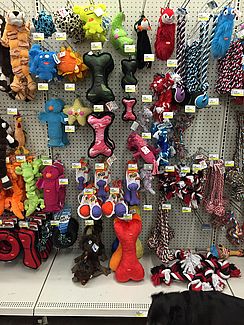 What about dogs that don’t like toys? Is it that they don’t like toys or they don’t know how to play with them? There’s such a huge variety of dog toys: Balls of all shapes and sizes, squeaky toys, hard and soft rubber toys, stuffed toys, tug toys, treat-dispensing toys, throwing toys, etc. There are dog toys in practically every shape, size and texture to appeal to all of your dog’s senses. Haley likes almost any kind of toy, except tennis balls because of the fuzzy texture on the outside of the ball. Every dog has their toy preferences, so it’s a good idea to experiment with a variety of toys to find out what appeals to your dog.
What about dogs that don’t like toys? Is it that they don’t like toys or they don’t know how to play with them? There’s such a huge variety of dog toys: Balls of all shapes and sizes, squeaky toys, hard and soft rubber toys, stuffed toys, tug toys, treat-dispensing toys, throwing toys, etc. There are dog toys in practically every shape, size and texture to appeal to all of your dog’s senses. Haley likes almost any kind of toy, except tennis balls because of the fuzzy texture on the outside of the ball. Every dog has their toy preferences, so it’s a good idea to experiment with a variety of toys to find out what appeals to your dog. 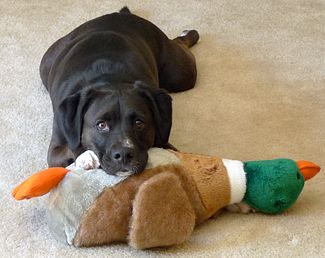 Puppies learn from playing with their mother and littermates and as adults they continue to learn by playing with you. It may seem like you’re just providing some casual entertainment for your pup while playing, but he’s learning manners, self-control and problem-solving skills. He’s also getting some mental stimulation and exercise while you build a strong bond together.
Puppies learn from playing with their mother and littermates and as adults they continue to learn by playing with you. It may seem like you’re just providing some casual entertainment for your pup while playing, but he’s learning manners, self-control and problem-solving skills. He’s also getting some mental stimulation and exercise while you build a strong bond together. 
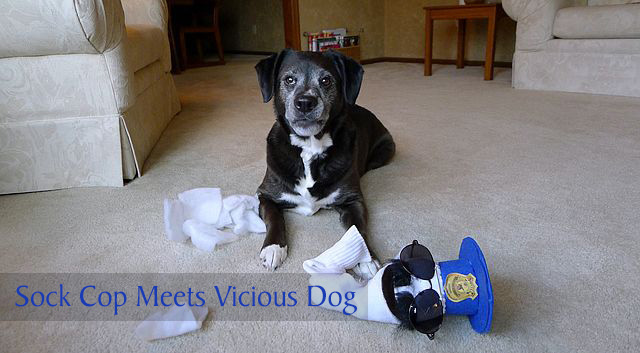 The title of this post probably means nothing to you unless you’ve been hanging out on Periscope lately. If you’re really confused now and are asking yourself “What the heck is Periscope?”, let me explain.
The title of this post probably means nothing to you unless you’ve been hanging out on Periscope lately. If you’re really confused now and are asking yourself “What the heck is Periscope?”, let me explain. Exercising your dog is important all year long. Last fall I wrote
Exercising your dog is important all year long. Last fall I wrote  Certain dogs are at increased risk for heat related illnesses and should mostly be kept indoors when it’s hot and humid. High temperatures can be extremely hard on older dogs, very young dogs, overweight dogs and dogs with short muzzles (bulldogs, pugs, Boston terriers, etc.) Dogs with heart or respiratory diseases should also be kept inside where it’s cooler. Most dogs appreciate being indoors if the weather is extremely hot, especially dogs with thick double coats.
Certain dogs are at increased risk for heat related illnesses and should mostly be kept indoors when it’s hot and humid. High temperatures can be extremely hard on older dogs, very young dogs, overweight dogs and dogs with short muzzles (bulldogs, pugs, Boston terriers, etc.) Dogs with heart or respiratory diseases should also be kept inside where it’s cooler. Most dogs appreciate being indoors if the weather is extremely hot, especially dogs with thick double coats. As temperatures and humidity levels climb, plan to adjust your dog’s exercise routine accordingly. Overweight dogs and dogs with darker colored coats tend to get overheated quicker when exercising in the sun and heat, so walk or exercise in the early morning or late evening when it’s cooler or take shorter walks in areas that are heavily shaded. Although I’ve never tried one on Haley, some dogs may enjoy wearing a cooling vest while exercising. If you’re visiting an area that’s much warmer than what your dog is accustomed to, allow her to adjust gradually to the warmer climate. Water-related activities are perfect for keeping dogs cool on sweltering summer days.
As temperatures and humidity levels climb, plan to adjust your dog’s exercise routine accordingly. Overweight dogs and dogs with darker colored coats tend to get overheated quicker when exercising in the sun and heat, so walk or exercise in the early morning or late evening when it’s cooler or take shorter walks in areas that are heavily shaded. Although I’ve never tried one on Haley, some dogs may enjoy wearing a cooling vest while exercising. If you’re visiting an area that’s much warmer than what your dog is accustomed to, allow her to adjust gradually to the warmer climate. Water-related activities are perfect for keeping dogs cool on sweltering summer days. 
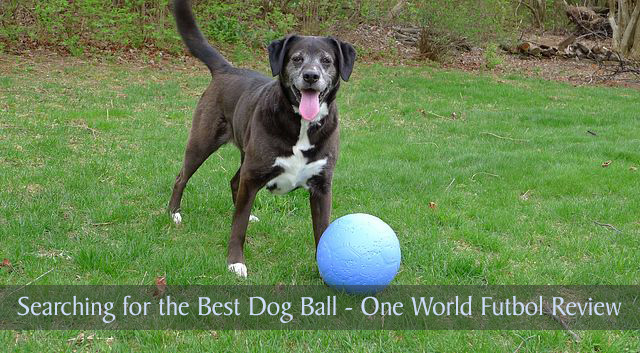
 What dog doesn’t like a ball to chase, right? There are more dog balls and toys on the market today than ever, so finding the best dog ball for your pup should be a pretty easy endeavor, unless you’re Haley of course. A lot of dogs like Haley enjoy bouncing balls off their noses, so lightweight balls like beach balls are perfect for this type of play. There’s just one problem though, they last about 30 seconds before those canine teeth puncture through the plastic and your dog parades around the room with their fresh kill. I guess it’s like popping bubble wrap to us humans.
What dog doesn’t like a ball to chase, right? There are more dog balls and toys on the market today than ever, so finding the best dog ball for your pup should be a pretty easy endeavor, unless you’re Haley of course. A lot of dogs like Haley enjoy bouncing balls off their noses, so lightweight balls like beach balls are perfect for this type of play. There’s just one problem though, they last about 30 seconds before those canine teeth puncture through the plastic and your dog parades around the room with their fresh kill. I guess it’s like popping bubble wrap to us humans.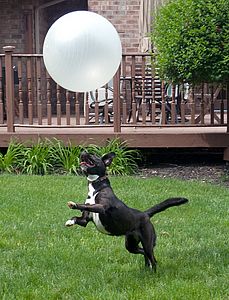 Haley’s tested a lot of inflatable balls, from beach balls to children’s inflatable toy balls to exercise balls but the only ball with some bounce that can withstand Haley’s fierce fangs has been a basketball. It’s been Haley’s ball of choice so far. Basketballs are pretty heavy though and tough on her nose, so I’m always keeping an eye out for other options. Which brings us to today’s post! A review of the One World Futbol by
Haley’s tested a lot of inflatable balls, from beach balls to children’s inflatable toy balls to exercise balls but the only ball with some bounce that can withstand Haley’s fierce fangs has been a basketball. It’s been Haley’s ball of choice so far. Basketballs are pretty heavy though and tough on her nose, so I’m always keeping an eye out for other options. Which brings us to today’s post! A review of the One World Futbol by 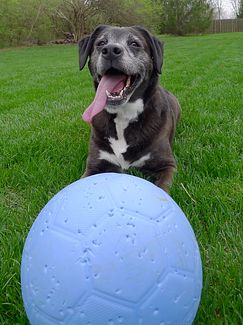 The self-inflating bladder built into the ball is designed for durability and practically indestructible play. The reason behind the design is something pretty special too. This ball was not designed for dogs, but designed for empowering youth and strengthening communities worldwide through play. The Buy One Give One program works like this, when you buy a One World Futbol, the project donates a second ball to an organization working with disadvantaged youth in various communities around the world, especially in areas affected by war, disasters, disease and poverty. The program’s founding sponsor is Chevrolet and through the Buy One Give One program, over one million balls have been donated and distributed throughout the world.
The self-inflating bladder built into the ball is designed for durability and practically indestructible play. The reason behind the design is something pretty special too. This ball was not designed for dogs, but designed for empowering youth and strengthening communities worldwide through play. The Buy One Give One program works like this, when you buy a One World Futbol, the project donates a second ball to an organization working with disadvantaged youth in various communities around the world, especially in areas affected by war, disasters, disease and poverty. The program’s founding sponsor is Chevrolet and through the Buy One Give One program, over one million balls have been donated and distributed throughout the world.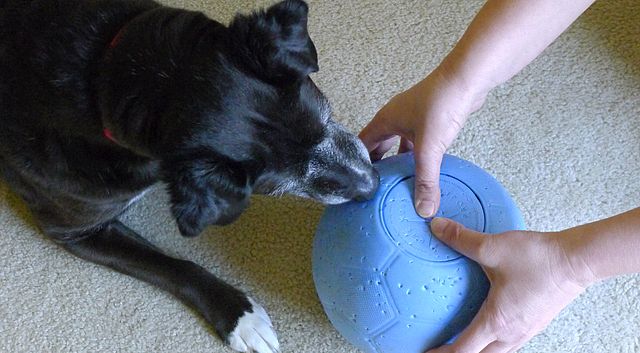
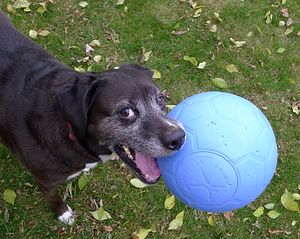 I was really impressed with the One World Futbol because it’s so durable and it has the built-in pump. Haley loves it almost as much as her basketball. The only negative point is she doesn’t chase it as much because it has a softer exterior and she tends to pick it up and carry it in her mouth, rather than push and chase it with her nose. The ball claims to be nearly indestructible and after six months of play, we haven’t had any issues with it and we haven’t had to add any additional air to the ball. Even though it’s covered with fang marks now, it’s held up well to all the tooth abuse. Haley gives it “two paws up” and I would highly recommend it for dogs, kids or adults.
I was really impressed with the One World Futbol because it’s so durable and it has the built-in pump. Haley loves it almost as much as her basketball. The only negative point is she doesn’t chase it as much because it has a softer exterior and she tends to pick it up and carry it in her mouth, rather than push and chase it with her nose. The ball claims to be nearly indestructible and after six months of play, we haven’t had any issues with it and we haven’t had to add any additional air to the ball. Even though it’s covered with fang marks now, it’s held up well to all the tooth abuse. Haley gives it “two paws up” and I would highly recommend it for dogs, kids or adults. 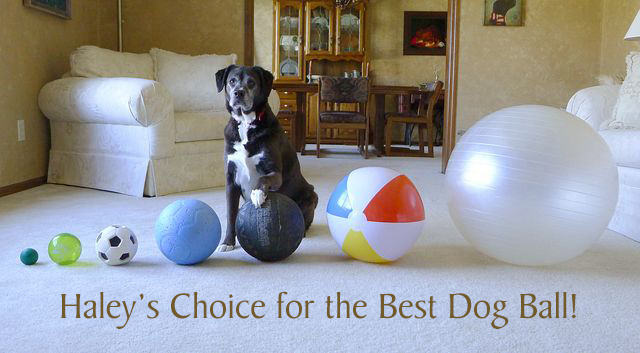 Our search for the best dog ball doesn’t end here, but this was a great investment for Haley and a great investment in kids around the world. Have you found the perfect ball for your dog? Tell us what it is and what your dog loves about it!
Our search for the best dog ball doesn’t end here, but this was a great investment for Haley and a great investment in kids around the world. Have you found the perfect ball for your dog? Tell us what it is and what your dog loves about it!
 Meet Max! He was one of our family dogs when I was growing up. Max was a master of destruction both inside the house and outside in the backyard. He was an expert on landscaping, or maybe I should say re-landscaping from the way he liked to tear out rose bushes from the roots and destroy them, thorns and all! Max had his own ideas on what a dog-friendly yard should look like and while he’s going to share his thoughts with you below, I’ll be throwing in my two cents too!
Meet Max! He was one of our family dogs when I was growing up. Max was a master of destruction both inside the house and outside in the backyard. He was an expert on landscaping, or maybe I should say re-landscaping from the way he liked to tear out rose bushes from the roots and destroy them, thorns and all! Max had his own ideas on what a dog-friendly yard should look like and while he’s going to share his thoughts with you below, I’ll be throwing in my two cents too!



